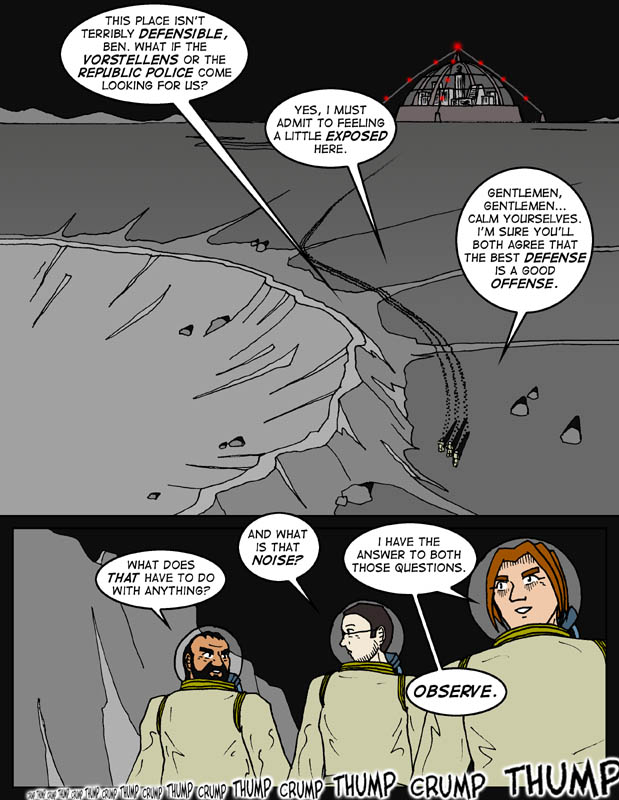
| ||
|
(Jon sez:)  Anyone who wonders how our three mad scientists can hear sound in the lunar
vacuum will see the answer on Thursday.
Anyone who wonders how our three mad scientists can hear sound in the lunar
vacuum will see the answer on Thursday.
Science time! That crater our friends are walking past is a simple crater. Simple craters are shaped (roughly) like bowls. Complex craters, on the other hand, are larger, shallower, and often have a central peak or uplift. This is because the ground has rebounded after the cratering event. Complex craters are generally created by larger objects than create simple craters. Larger than the complex craters are impact basins, which are hundreds of kilometers across and seriously deform the crust. The largest impact basins form some of the Moon's maria (seas). Simple and complex craters form on the surface of the other moons and planets as well. Meteor Crater in the American southwest is simple, whereas the western Clearwater Lake in Canada is complex. The ring island in the lake is the central uplift. Some complex craters, such as this one, have ring structures instead of central peaks. |
(Mark sez:)  I'm just going to say that I think that crater ended up looking mighty fine. I've also made a stylistic change on this page. Previously the skies on the Moon were portrayed as being jam-packed with stars. This is scientifically accurate -- the Apollo astronauts were able to see the stars with ease -- but doesn't quite work artistically, because no stars are visible in the photos taken on the Moon that have formed our mental picture of what the place looks like. (This was due to the exposure settings in the cameras the astronauts used -- you can't simultaneously photograph both the starkly lit lunar surface and the by-comparison extremely dark stars in the sky.) So now the outdoor skies on the Moon during the daytime are jet-black, which I think is an improvement over previous scenes.
I'm just going to say that I think that crater ended up looking mighty fine. I've also made a stylistic change on this page. Previously the skies on the Moon were portrayed as being jam-packed with stars. This is scientifically accurate -- the Apollo astronauts were able to see the stars with ease -- but doesn't quite work artistically, because no stars are visible in the photos taken on the Moon that have formed our mental picture of what the place looks like. (This was due to the exposure settings in the cameras the astronauts used -- you can't simultaneously photograph both the starkly lit lunar surface and the by-comparison extremely dark stars in the sky.) So now the outdoor skies on the Moon during the daytime are jet-black, which I think is an improvement over previous scenes.
Speaking of stuff that looks good, I actually had enough spare time to draw something that's not Miracle of Science recently. It's over here in the Miscellaneous 'T' section of my website. I hope you like it, 'cos I certainly do. |
|